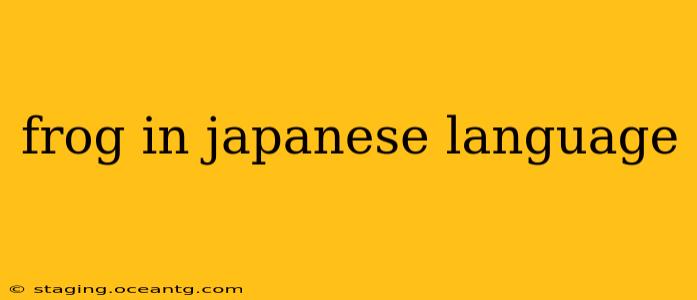The Japanese language, rich in its vocabulary and nuances, offers several ways to say "frog." The best term to use depends on the context, the specific type of frog, and the level of formality. This guide will explore the various ways to describe frogs in Japanese, helping you choose the most appropriate word for your situation.
What is the most common word for frog in Japanese?
The most common and widely understood word for frog in Japanese is カエル (kaeru). This is a general term and suitable for most situations. It's simple, easily recognizable, and perfectly acceptable in both casual and formal conversations.
Are there other words for frog in Japanese?
While カエル (kaeru) is the most prevalent, several other words exist, each with subtle differences in meaning or usage:
Types of Frogs and their Japanese Names:
While not always commonly used, knowing the specific type of frog can lead to more precise terminology. For instance, some Japanese names might refer to a particular frog's appearance or habitat. Unfortunately, a direct translation of every frog species into Japanese doesn't exist, mirroring the situation in English. Deep diving into specialized herpetological texts in Japanese would be required to find species-specific names.
Regional Variations:
Like many languages, Japanese has regional dialects. While カエル (kaeru) is understood across the country, you might encounter slight variations in pronunciation or even alternative words in specific regions. These are usually less common and less likely to be encountered by non-native speakers.
What are some phrases related to frogs in Japanese?
Beyond single words, several idioms and expressions involving frogs exist in Japanese. These can add depth and color to your communication:
-
蛙の子は蛙 (kaeru no ko wa kaeru): This idiom translates to "Like father, like son" or "The apple doesn't fall far from the tree." It refers to the inheritance of traits from parents to offspring.
-
井の中の蛙大海を知らず (i no naka no kaeru taikai wo shirazu): This proverb means "A frog in a well doesn't know the great ocean." It describes someone with a limited perspective or experience, unaware of the larger world.
How do you say "frog prince" in Japanese?
The phrase "frog prince" doesn't have a direct, single-word translation. However, you could convey the meaning using the following:
- カエルの王子様 (kaeru no oujisama): This literally translates to "frog prince," and it's a perfectly understandable and commonly used expression.
What are some other related questions about frogs in Japanese?
While researching this topic, several related questions frequently arise. Here are a few, along with their answers:
What's the difference between using カエル (kaeru) and other less common words?
The main difference lies in frequency and context. カエル (kaeru) is universally understood and suitable for almost any scenario. Less common words are mostly used only when referring to a specific kind of frog or in specialized contexts.
Are there any kanji characters associated with "frog"?
Yes, カエル can be written using kanji characters, though it's less common than the hiragana spelling. The kanji characters are typically 蛙.
This comprehensive guide provides a thorough overview of how to say "frog" in Japanese, considering various contexts and nuances. Remember, while カエル (kaeru) is the most versatile and commonly used term, understanding the subtle differences in other terms and expressions can enrich your Japanese vocabulary.
